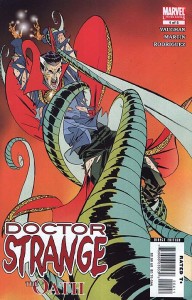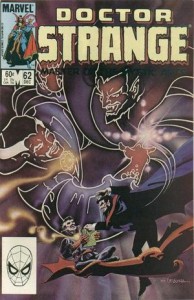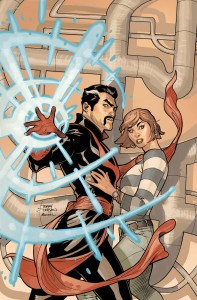With Marvel’s Doctor Strange opening in theaters this weekend, Deadshirt.net looks back at some of the very best comics starring the good doctor. Max Robinson, David Uzumeri, and Dominic Griffin share why Doctor Strange is the Sorcerer Supreme!
Written by Roger Stern
Art by Dan Green and Steve Leialoha
As with many of Marvel’s long-lived but — until recently — fairly low profile characters, Dr. Stephen Strange has very few “essential” stories from the ’80s. Daredevil has “The Elektra Saga,” Spidey has “Kraven’s Last Hunt,” take your pick from the X-Men. My pick for Dr. Strange’s unheralded excellent comic? “The Montessi Formula,” which refers to a five issue arc that pitted Dr. Strange against Marvel’s best reinterpretation of the public domain villain, Dracula.
While Dracula’s solo adventures in Tomb of Dracula had wrapped up years earlier, Stern and co. brought him back from the dead for the kind of far out, high stakes story you can only tell with a character like Dr. Strange. Dracula, revived by a cult that worships the demonic tome known as The Darkhold, is reborn and slowly loses his traditional vampire weaknesses thanks to a willingness to embrace sorcery. Strange and Wong team up with former Tomb of Dracula cast members Frank Drake, Blade and vampire detective Hannibal King to not just kill Dracula, but destroy every vampire on earth in one fell swoop. Talk about ambitious.
Like the Mark Gruenwald/Kieron Dwyer’s “Bloodstone Hunt” arc that would run through Captain America six years later, “The Montessi Formula” is the kind of crazy globe-hopping superhero comic you can’t really do today in six issues. Stern’s script is wildly inventive, a clever battle of wits between Strange and Dracula that spans from an assault on Avengers Mansion to Baron Mordo’s abandoned Transylvanian castle. It’s an adventure comic in the most classic sense of the term. While everyone on Strange’s team will do anything to stop Dracula, King fights with the knowledge that he’ll likely die if they do win. Strange and Dracula one-up each other over and over, with the penultimate issue culminating in Dracula CRASHING A RUSSIAN JET into the Transylvanian mountainside just before his final showdown with the intrepid vampire hunters.
Doctor Strange #62 is the real gem of this arc, with Steve Leialoha on art duties. Green’s pencils through most of the arc are totally fine, but Leialoha’s work here is eerie and moody, with lots of heavy shadows. The pages look more like a horror comic than a traditional superhero book and it’s, fittingly, very evocative of Gene Colan’s work on Tomb of Dracula. Strange and co. successfully destroy Dracula (and every vampire on Earth) and even end up transforming King back into a human. This status quo naturally didn’t stick for too long, but you have to admire Stern’s guts as a writer that he swung for the fences like this. “The Montessi Formula” has all the vampiric minions and battles on the astral plane you could want from a Marvel comic.
— Max Robinson
Doctor Strange: The Oath #1-5 (2007) 
Written by Brian K. Vaughan
Art by Marcos Martín and Álvaro López
Colored by Javier Rodriguez
This is probably the clichéd answer to “favorite Doctor Strange story,” but as someone who really got into the Marvel Universe for the first time with the beginning of the New Avengers era, this was the first big Doctor Strange standalone story of that period, and the first one to make me get what his appeal was as a protagonist, and the Marvel-style feet-of-clay flaw that made that dude who showed up in all the other comics to explain the plot actually an interesting concept on its own merits.
Brian K. Vaughan is traditionally seen as a writer who’s more successful playing with his own toys than other peoples’, despite having written some pretty great Batman and X-Men stories — that stuff’s towered over by the reputation and popularity of stuff like Y: The Last Man with Pia Guerra, Ex Machina with Tony Harris and especially his megahit Saga with Fiona Staples. Still, I think there’s a general group consensus that his strongest work-for-hire book is this, his first pairing with the exceptional Marcos Martín, backed up by Álvaro López on inks and Javier Rodriguez — now a very accomplished penciler in his own right — on colors. While many artists — most notably Tom Scioli — have taken Jack Kirby as an origin point for their styles, Martín remains one of the few superhero/direct market artists I can think of working from Steve Ditko. He draws the weird Ditko hand gestures better than anyone currently working, and his best work is always with outlandish dreamscapes, inventive panel layouts and expressive body language.
It’s an audacious premise, pitting Doctor Strange’s oath to Earth as its Sorcerer Supreme and his oath as a surgeon in direct conflict, presenting him with essentially the ultimate dilemma to his character: when presented with a magical cure for disease, is he a Sorcerer Supreme — who holds it back to prevent mankind from advancing too far too fast and running to extinction — or is he a surgeon who swore the Hippocratic Oath to treat his patients at all cost? The story’s resolution to this question is affecting and earns it, but Strange’s internal struggle feels real, as he perseveres under the weight of his conflicting promises while colliding with unseen adversaries and secrets from his past. It’s an effective, affecting story that could only be told with Doctor Strange, bringing together two of the biggest names in comics for the first time in an extended homage to weirdness, fucked-up fingers and the positions they can make, extradimensional hellscapes and the great, weird Steve Ditko himself.
— David Uzumeri
Story by Matt Fraction
Art by Michael Lark, Stefano Gaudiano, Brian Thies
Colors by Matt Hollingsworth
Lettered by Clayton Cowles
For a long time, Doctor Strange’s presence in the Marvel Universe was relegated to guest star status. He’d pop up to explain necessary magic bullshit the way Nick Fury might with clandestine spy crap, but his characterization became thinner and thinner.In some books he was little more than an NPC telling Spider-Man or whoever how to get to the next province. He’s slowly found himself closer to center stage in recent years, especially with the new film on the horizon, but few creators captured such a unique take on the character as Matt Fraction penned in his short lived Defenders experiment.
Conceived as a team book concerned with unraveling the secret history of the Marvel Universe, Defenders did a great many entertaining things, but its depiction of Doctor Strange as an arcane, unknowable scumbag was perhaps its most fascinating element. In interviews, Fraction said his inspiration was actor James Spader, a man possessed of undeniable charm and mystique, but also an omnipresent sense of discomfort. “You wouldn’t want to be on a long car ride with him,” Fraction mused. In the first three issues of the series, Terry and Rachel Dodson’s interpretation of Strange as a sort of muscleman Geraldo Rivera works at odds with the book’s writing, but issue four’s standalone tale brings in Michael Lark, who’s more than game to turn the Sorcerer Supreme into textured character actor weirdness.
This issue serves as something of an interlude as well as a callback to a throwaway bit from the first issue. Strange, Iron Fist, Red She-Hulk, The Silver Surfer and Namor have discovered an ancient machine of sorts with power and history beyond comprehension. Strange requires solitude to study the device, but becomes stuck between two women, a college student named Molly he had a sleazy one night stand with back in issue #1, and Martha, an old flame he’s accidentally brought back to life with the wishing machine. The central threat of the issue is a predatory street magician who tries to use Molly to steal power from Strange, but the real highlight of this story is the collateral damage that surrounds the good Doctor.
Strange here is meant to be a gatekeeper above reproach. That’s why he’s Sorcerer Supreme. That’s why he can be left alone with a weird extradimensional relic of immeasurable power. But he’s just a man. Like all great Marvel protagonists, Strange has an underlying fallibility that makes him relatable. For years that fundamentally flawed nature seemed absent, but Fraction brings it back to the fore here. What makes it special is that it’s utterly strip mined of any sugarcoating charm. This isn’t Tony Stark masking his solipsism in stammering one liners and winking deprecation. This is an aging man living alone in the Village with his dusty books putting his own loneliness above the feelings of others. By the end of the issue, Strange is reminded of how callous he can really be, but it doesn’t change the human rubble he leaves in his wake.
— Dominic Griffin



